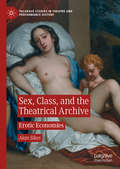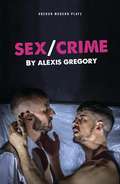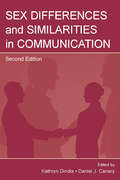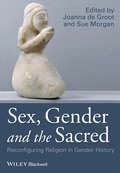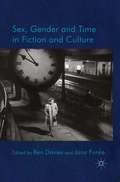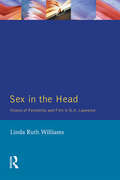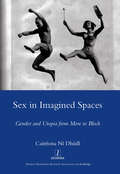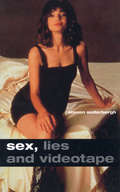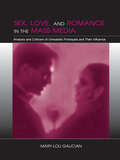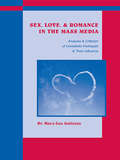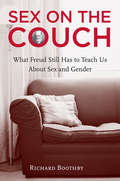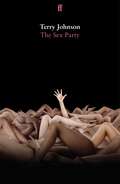- Table View
- List View
Sex, Class and Culture (Routledge Revivals)
by Lillian RobinsonFirst published in 1986, Sex, Class and Culture is a collection of Marxist feminist essays that develops an original critical theory and applies it to literature, the visual arts, and mass media. Lillian Robinson was the first American critic to suggest the essential connections among sex, class, and race as forces that shape works of art and the critical response to them. In applying her theory to particular texts, she considers topics from the Renaissance epic to the Regency romance, from Jane Austen to contemporary feminist poets, and from factory workers’ memoirs to TV images of career women and housewives. The essays are insightful because Robinson clearly knows this wide assortment of texts, cares about their significance, and writes about them with wit. They are irreverent, because she asserts the feminist critic’s permanent responsibility to ask "So What?" and they are controversial because she constantly addresses that question to our most powerful and respectable institutions – social and literary. This book will be of interest to students of literature, history, gender studies and sexuality studies.
Sex, Class, and the Theatrical Archive: Erotic Economies (Palgrave Studies in Theatre and Performance History)
by Alan SikesIn Sex, Class and the Theatrical Archive: Erotic Economies, Alan Sikes explores the intersection of struggles over sex and class identities in politicized performances during key revolutionary moments in modern European history. The book includes discussions of sodomitical closet dramas from the decades surrounding the English Glorious Revolution of 1688; the performances of 'Tribades and Amazons', public women of the French Revolution; the 'homophilic elitism' in the early plays of Brecht and Hasenclever from the years just before and after the German Revolution that marked the founding of the short-lived Weimar Republic; and the utopian conception of a Soviet 'New Woman' set to take the stage after the Russian Revolution of 1917. Throughout, Sikes invokes the differences between past and present politicized performances in order to cast our own political imaginings into sharper and more critical relief.
Sex/Crime (Oberon Modern Plays)
by Alexis GregoryIn a fractured and divided city, two men, ‘A’ and ‘B’, meet to recreate the killings of a famous gay serial killer, for their own pleasure…and the right price. “Everything else is tumbling downFalling apartBut not you and me You and me are going to hold tight You and me are just right” Sex/Crime is a darkly comic queer thriller: an exciting, challenging play that explores sex, violence, language, fear and queerness.
Sex Differences and Similarities in Communication (Routledge Communication Series)
by Daniel J. Canary Kathryn DindiaSex Differences and Similarities in Communication offers a thorough exploration of sex differences in how men and women communicate, set within the context of sex similarities, offering a balanced examination of the topic. The contents of this distinctive volume frame the conversation regarding the extent to which sex differences are found in social behavior, and emphasize different theoretical perspectives on the topic. Chapter contributors examine how sex differences and similarities can be seen in various verbal and nonverbal communicative behaviors across contexts, and focus on communication behavior in romantic relationships. The work included here represents recent research on the topic across various disciplines, including communication, social psychology, sociology, linguistics, and organizational behavior, by scholars well-known for their work in this area. In this second edition, some chapters present new perspectives on sex/gender and communication; others present substantially revised versions of earlier chapters. All chapters have a stronger theoretical orientation and are based on a wider range of empirical data than those in the first edition. Readers in communication, social psychology, relationships, and related fields will find much of interest in this second edition. The volume will serve as a text for students in advanced coursework as well as a reference for practitioners interested in research-based conclusions regarding sex differences in communicative behavior.
Sex Differences and Similarities in Communication (Routledge Communication Series)
by Kathryn Dindia Daniel J. CanarySex Differences and Similarities in Communication offers a thorough exploration of sex differences in how men and women communicate, set within the context of sex similarities, offering a balanced examination of the topic. The contents of this distinctive volume frame the conversation regarding the extent to which sex differences are found in social behavior, and emphasize different theoretical perspectives on the topic. Chapter contributors examine how sex differences and similarities can be seen in various verbal and nonverbal communicative behaviors across contexts, and focus on communication behavior in romantic relationships. The work included here represents recent research on the topic across various disciplines, including communication, social psychology, sociology, linguistics, and organizational behavior, by scholars well-known for their work in this area. In this second edition, some chapters present new perspectives on sex/gender and communication; others present substantially revised versions of earlier chapters. All chapters have a stronger theoretical orientation and are based on a wider range of empirical data than those in the first edition. Readers in communication, social psychology, relationships, and related fields will find much of interest in this second edition. The volume will serve as a text for students in advanced coursework as well as a reference for practitioners interested in research-based conclusions regarding sex differences in communicative behavior.
Sex, Gender and the Sacred: Reconfiguring Religion in Gender History (Gender and History Special Issues)
by Joanna De Groot Sue MorganSex, Gender and the Sacred presents a multi-faith, multi-disciplinary collection of essays that explore the interlocking narratives of religion and gender encompassing 4,000 years of history. Contains readings relating to sex and religion that encompass 4,000 years of gender history Features new research in religion and gender across diverse cultures, periods, and religious traditions Presents multi-faith and multi-disciplinary perspectives with significant comparative potential Offers original theories and concepts relating to gender, religion, and sexuality Includes innovative interpretations of the connections between visual, verbal, and material aspects of particular religious traditions
Sex, Gender and the Sacred: Reconfiguring Religion in Gender History (Gender and History Special Issues)
by Joanna De Groot Sue MorganSex, Gender and the Sacred presents a multi-faith, multi-disciplinary collection of essays that explore the interlocking narratives of religion and gender encompassing 4,000 years of history. Contains readings relating to sex and religion that encompass 4,000 years of gender history Features new research in religion and gender across diverse cultures, periods, and religious traditions Presents multi-faith and multi-disciplinary perspectives with significant comparative potential Offers original theories and concepts relating to gender, religion, and sexuality Includes innovative interpretations of the connections between visual, verbal, and material aspects of particular religious traditions
Sex, Gender and Time in Fiction and Culture
by Ben Davies, Jana FunkeInvestigating modern art, literature, theory and the law, this book illustrates the different ways in which sex, gender and time intersect. It demonstrates that time offers new critical perspectives on sex and gender and makes problematic reductive understandings of sexual identity as well as straight and queer time
Sex in Consumer Culture: The Erotic Content of Media and Marketing (Routledge Communication Series)
by Tom Reichert Jacqueline LambiaseSex in Consumer Culture: The Erotic Content of Media and Marketing considers the use of sex to promote brands, magazines, video games, TV programming, music, and movies. Offering both quantitative and qualitative perspectives from leading scholars in a variety of disciplines, this volume addresses a range of integral issues such as media promotion, racial representations, appeals to gay and lesbian communities, content analyses, and case studies. Chapters represent diverse perspectives, addressing such questions as:*What happens when sexual content created for adults reaches children?*What meaning do sexual words and images have within the contexts of sporting events, trade shows, video games, personal ads, or consumer Web sites?*What effects might sex-tinged images have on audiences, and where should the focus be for new effects research?*Where are the current boundaries between pornography and mainstream sexual depictions?Exploring sexual information as it is used in mass media to sell products and programs, Sex in Consumer Culture is an important collection, and it will be of great interest for scholars and students in advertising, marketing, media promotion, persuasion, mass communication & society, and gender studies.
Sex in Consumer Culture: The Erotic Content of Media and Marketing (Routledge Communication Series)
by Tom Reichert Jacqueline LambiaseSex in Consumer Culture: The Erotic Content of Media and Marketing considers the use of sex to promote brands, magazines, video games, TV programming, music, and movies. Offering both quantitative and qualitative perspectives from leading scholars in a variety of disciplines, this volume addresses a range of integral issues such as media promotion, racial representations, appeals to gay and lesbian communities, content analyses, and case studies. Chapters represent diverse perspectives, addressing such questions as:*What happens when sexual content created for adults reaches children?*What meaning do sexual words and images have within the contexts of sporting events, trade shows, video games, personal ads, or consumer Web sites?*What effects might sex-tinged images have on audiences, and where should the focus be for new effects research?*Where are the current boundaries between pornography and mainstream sexual depictions?Exploring sexual information as it is used in mass media to sell products and programs, Sex in Consumer Culture is an important collection, and it will be of great interest for scholars and students in advertising, marketing, media promotion, persuasion, mass communication & society, and gender studies.
Sex In The Head: Visions of Femininity and Film in D.H. Lawrence
by Linda R. WilliamsIn Sex in the Head, Linda Ruth Williams uses psychoanalysis and recent feminist film theory to analyze a network of ideas which link looking with sexuality and difference, in the work of a writer who disavowed, yet covertly enjoyed, the pleasures and power of vision. The book is a departure from the long history of feminist readings of Lawrence, in that it discusses his engagement with theories of the gaze and its cultural forms - cinema, photography, painting and the visual dynamics and metaphors of literary texts - as a way of thinking through gender. It shows him arguing, on the one hand, against the evils of cinema and visual sex, while relishing, through the eyes of women, the moving spectacle of those male bodies which populate the pages of his books. It also questions what it is about the work of such an adamant cinephobe which has made it so thoroughly adaptable for film and television.
Sex In The Head: Visions of Femininity and Film in D.H. Lawrence
by Linda R. WilliamsIn Sex in the Head, Linda Ruth Williams uses psychoanalysis and recent feminist film theory to analyze a network of ideas which link looking with sexuality and difference, in the work of a writer who disavowed, yet covertly enjoyed, the pleasures and power of vision. The book is a departure from the long history of feminist readings of Lawrence, in that it discusses his engagement with theories of the gaze and its cultural forms - cinema, photography, painting and the visual dynamics and metaphors of literary texts - as a way of thinking through gender. It shows him arguing, on the one hand, against the evils of cinema and visual sex, while relishing, through the eyes of women, the moving spectacle of those male bodies which populate the pages of his books. It also questions what it is about the work of such an adamant cinephobe which has made it so thoroughly adaptable for film and television.
Sex in Imagined Spaces: Gender and Utopia from More to Bloch
by Caitriona DhuillFrom Thomas More onwards, writers of utopias have constructed alternative models of society as a way of commenting critically on existing social orders. In the utopian alternative, the sex-gender system of the contemporary society may be either reproduced or radically re-organised. Reading utopian writing as a dialogue between reality and possibility, this study examines the relationship between historical sex-gender systems and those envisioned by utopian texts. Surveying a broad range of utopian writing from the nineteenth and twentieth centuries, including Huxley, Zamyatin, Wedekind, Hauptmann, and Charlotte Perkins Gilman, this book reveals the variety and complexity of approaches to re-arranging gender, and locates these 're-arrangements' within contemporary debates on sex and reproduction, masculinity and femininity, desire, taboo and family structure. These issues occupy a position of central importance in the dialogue between utopian imagination and anti-utopian thought which culminates in the great dystopias of the twentieth century and the postmodern re-invention of utopia.
Sex in Imagined Spaces: Gender and Utopia from More to Bloch
by Caitriona DhuillFrom Thomas More onwards, writers of utopias have constructed alternative models of society as a way of commenting critically on existing social orders. In the utopian alternative, the sex-gender system of the contemporary society may be either reproduced or radically re-organised. Reading utopian writing as a dialogue between reality and possibility, this study examines the relationship between historical sex-gender systems and those envisioned by utopian texts. Surveying a broad range of utopian writing from the nineteenth and twentieth centuries, including Huxley, Zamyatin, Wedekind, Hauptmann, and Charlotte Perkins Gilman, this book reveals the variety and complexity of approaches to re-arranging gender, and locates these 're-arrangements' within contemporary debates on sex and reproduction, masculinity and femininity, desire, taboo and family structure. These issues occupy a position of central importance in the dialogue between utopian imagination and anti-utopian thought which culminates in the great dystopias of the twentieth century and the postmodern re-invention of utopia.
Sex in Language: Euphemistic and Dysphemistic Metaphors in Internet forums
by Eliecer Crespo-FernándezMetaphor has long provided a rich way to speak about the unspeakable, to refer to delicate issues. Sex is one such area. This book follows a cognitive-linguistic and relevance-theoretic approach to the language of sex, considering metaphor as a bridge that brings together mind and language. It does this through the analysis of the antithetical mechanisms of verbal mitigation and offence. These two mechanisms are (more commonly know as) euphemism and (its lesser known companion term) dysphemism.The volume reflects on the social and communicative functions that sexual metaphors perform in a sample of almost two hundred postings taken from internet forums. How do people think about sex? How do people avoid talking about sex? How do people paraphrase sexual topics? It offers an account of how real language users understand sexual taboo in present-day English and also a great grounding in manual corpus work on a qualitative level.
Sex in Language: Euphemistic and Dysphemistic Metaphors in Internet forums
by Eliecer Crespo-FernándezMetaphor has long provided a rich way to speak about the unspeakable, to refer to delicate issues. Sex is one such area. This book follows a cognitive-linguistic and relevance-theoretic approach to the language of sex, considering metaphor as a bridge that brings together mind and language. It does this through the analysis of the antithetical mechanisms of verbal mitigation and offence. These two mechanisms are (more commonly know as) euphemism and (its lesser known companion term) dysphemism.The volume reflects on the social and communicative functions that sexual metaphors perform in a sample of almost two hundred postings taken from internet forums. How do people think about sex? How do people avoid talking about sex? How do people paraphrase sexual topics? It offers an account of how real language users understand sexual taboo in present-day English and also a great grounding in manual corpus work on a qualitative level.
Sex in Public: The Incarnation of Early Soviet Ideology (Princeton Legacy Library #5236)
by Eric NaimanSex in Public examines the ideological poetics and the rhetoric of power in the Soviet Union during the 1920s, a period of anxiety over the historical legitimacy of Soviet ideology and Bolshevik power. Drawing on a wide range of soruces—Party Congress transcripts, the classics of early Soviet literature, sex education pamphlets, the cinema, crime reports, and early Soviet ventures into popular science—the author seeks to explain the period's preoccupation with crime, disease, and, especially, sex. Using strategies of reading developed by literary scholars, he devotes special care to exploring the role of narrative in authoritative political texts. The book breaks new ground in its attention to the ideological importance of the female body during this important formative stage of Bolshevik rule.Sex in Public provides a fundamentally new history of the New Economic Policy and offers important revisionist readings of many of the fundamental cultural products of the early Soviet period. Perhaps most important, it serves as a model for the sort of interdisciplinary work that is possible when historians take literary and ideology theory seriously and when ideology theorists seek to conform to the standards of documentary rigor traditionally demanded by historians. It thus becomes a study that can be read as both positivistic and postmodern.Eric Naiman is Associate Professor of Russian and Comparative Literature at the University of California, Berkeley.Originally published in 1997.The Princeton Legacy Library uses the latest print-on-demand technology to again make available previously out-of-print books from the distinguished backlist of Princeton University Press. These editions preserve the original texts of these important books while presenting them in durable paperback and hardcover editions. The goal of the Princeton Legacy Library is to vastly increase access to the rich scholarly heritage found in the thousands of books published by Princeton University Press since its founding in 1905.
Sex, Lies and Book Publishing: What You Need to Know
by Rupert HeathKeep your friends close. Keep your enemies closer. Keep your publisher closest of all. If you are interested in being published, you should do all you can to make the publishing business interested in you. But how? You've already written a good book, so what else do you have to do to give yourself the edge with agents and publishers? Sex, Lies & Book Publishing is your field guide to the nature of publishing - the unspoken rules and conventions deciding which books get published and which don't based on the way the industry and its denizens think and act. It is an up-to-date insider's guide to an often mysterious business, and an invaluable resource for any author seeking an agent and, ultimately, a publishing deal. Sex, Lies & Book Publishing lifts the lid on the publishing world today, and the people who work in it - from the occasionally eyebrow-raising private lives of book editors, to the ways they judge new fiction and non-fiction and prepare it for publication. This guide is packed with trade secrets you won't read anywhere else, including some which publishers might just prefer went unprinted.
sex, lies and videotape (Faber Reel Classics Ser.)
by Steven SoderberghLike Michael Powell's Peeping Tom, Steven Soderbergh's sex, lies and videotape presents us with a protagonist who can only connect with others through the lens of a camera. Graham is an enigmatic young man who returns to Baton Rouge from a long road trip, mildly irritating his old lawyer friend John and wholly intriguing John's housebound wife Ann. John is conducting a sneaky and entirely sexual affair with Ann's sister Cynthia. For her part, Ann has lost interest in sex, yet Graham's obscurely charming eccentricity stirs something inside her - until she learns that he is functionally impotent and can manage arousal only with the help of a video camera and an agreeably loose-lipped female. Nevertheless, it's the dragging into the open of Graham's dirty little secret that causes all of these characters to confront their own veiled deceits and hypocrisies.sex, lies and videotape won the Palme d'Or at the 1989 Cannes Film Festival, affirming the arrival of a distinctive new talent and signalling the start of a movement among young independent American film-makers opposed to the values and formats of the Hollywood system. Soderbergh's script is an unerringly elegant, witty and literate study of contemporary perversity.
Sex, Love, and Romance in the Mass Media: Analysis and Criticism of Unrealistic Portrayals and Their Influence
by Mary-Lou GalicianThis accessible yet research-based text offers both foundational theories and practical applications of analysis and criticism of mass media portrayals of sex, love, and romance in a wide variety of mass media, from entertainment to advertising to news. The multidisciplinary methodological perspective comes out of a media literacy approach and embraces a variety of traditions along the quantitative-qualitative continuum. Focused on portrayals of male-female coupleship, the book is centered around the 12 major myths and stereotypes of Galician's Dr. FUN!'s Mass Media Love Quiz©, each of which has a corresponding Dr. Galician Prescription® that encapsulates healthy strategies--rarely found in the mass media--to counteract that myth or stereotype. Readers learn how to identify, illustrate, deconstruct, evaluate, and reframe the mass media's mythic and stereotypic portrayals of sex, love, and romance. They also learn how to use their own formal critical evaluations to clarify their own values and--as media consumers or mass communication creators--to share their insights with others. Thus, the learning objectives encompass all three major educational domains: cognitive, affective, and behavioral. Part I of this book covers the five foundations: *myths and stereotypes of love and coupleship;*models of realistic and constructive love and coupleship;*mass media storytelling approaches, techniques, and devices;*research and theories of mass media effects; and*strategies and skills of media literacy. Part II is devoted to exploring the myths and stereotypes identified in the Quiz. Following several brief case studies and a summary of related research and commentary, each chapter focuses on analyses and criticisms of portrayals of sex, love, and romance in the content of news and advertising, as well as entertainment using Galician's Seven-Step Dis-illusioning Directions. Each chapter concludes with a "Dis-illusion Digest."While critical of unrealistic portrayals and the damage they can cause unsuspecting media consumers, Galician--a media literacy advocate--is not anti-media. Rather, her goal is to empower consumers to use these portrayals with more awareness of their possible consequences, to resist adopting them as models for actual behavior, and to consciously reframe them into more realistic, productive scenarios. This unique text is an engaging classroom resource for media literacy, media and relationships, and media and society coursework.
Sex, Love, and Romance in the Mass Media: Analysis and Criticism of Unrealistic Portrayals and Their Influence
by Mary-Lou GalicianThis accessible yet research-based text offers both foundational theories and practical applications of analysis and criticism of mass media portrayals of sex, love, and romance in a wide variety of mass media, from entertainment to advertising to news. The multidisciplinary methodological perspective comes out of a media literacy approach and embraces a variety of traditions along the quantitative-qualitative continuum. Focused on portrayals of male-female coupleship, the book is centered around the 12 major myths and stereotypes of Galician's Dr. FUN!'s Mass Media Love Quiz©, each of which has a corresponding Dr. Galician Prescription® that encapsulates healthy strategies--rarely found in the mass media--to counteract that myth or stereotype. Readers learn how to identify, illustrate, deconstruct, evaluate, and reframe the mass media's mythic and stereotypic portrayals of sex, love, and romance. They also learn how to use their own formal critical evaluations to clarify their own values and--as media consumers or mass communication creators--to share their insights with others. Thus, the learning objectives encompass all three major educational domains: cognitive, affective, and behavioral. Part I of this book covers the five foundations: *myths and stereotypes of love and coupleship;*models of realistic and constructive love and coupleship;*mass media storytelling approaches, techniques, and devices;*research and theories of mass media effects; and*strategies and skills of media literacy. Part II is devoted to exploring the myths and stereotypes identified in the Quiz. Following several brief case studies and a summary of related research and commentary, each chapter focuses on analyses and criticisms of portrayals of sex, love, and romance in the content of news and advertising, as well as entertainment using Galician's Seven-Step Dis-illusioning Directions. Each chapter concludes with a "Dis-illusion Digest."While critical of unrealistic portrayals and the damage they can cause unsuspecting media consumers, Galician--a media literacy advocate--is not anti-media. Rather, her goal is to empower consumers to use these portrayals with more awareness of their possible consequences, to resist adopting them as models for actual behavior, and to consciously reframe them into more realistic, productive scenarios. This unique text is an engaging classroom resource for media literacy, media and relationships, and media and society coursework.
Sex, machines and navels: Fiction, fantasy and history in the future present
by Fred BottingAvailable again in paperback, this study offers a rigorous critical re-reading of fictions of humanity, history, technology and postmodern culture.Taking psychoanalysis into cyberspace, the book develops an innovative theoretical perspective on the relationship between bodies and machines to offer a focused re-examination of notions of desire, metaphor, sexed identity and difference and the process of technological transformation.The book unravels one figure in a detailed, lucid and extensive revision of Lacanian psychoanalysis in association with postmodern theory, feminism and deconstruction. Problematising the easy conjunction of human bodies and inhuman technology, the navel opens into networks of desire, history, culture and machines. Linked to the unconscious, to jokes and dreams, navels appear on the bodies of replicants and in the technological matrix, a strange excess in a future imagined in terms of corporeal ‘meat’ or posthuman machine. Exploring the significance of this omphalic excess, the book closely examines postmodern and cyberpunk texts (by Thomas Pynchon, Graham Swift, Julian Barnes, William Gibson, Rudy Rucker) alongside detailed readings of contemporary cultural critics and theorists.
Sex on the Couch: What Freud Still Has To Teach Us About Sex and Gender
by Richard BoothbyFirst published in 2006. Routledge is an imprint of Taylor & Francis, an informa company.
Sex on the Couch: What Freud Still Has To Teach Us About Sex and Gender
by Richard BoothbyFirst published in 2006. Routledge is an imprint of Taylor & Francis, an informa company.
The Sex Party
by Terry JohnsonWell yes and no. It's sexy, but pedestrian. Hieronymus Bosch in Smethwick. Hetty and I found a little alcove with our Sauvignon.Four couples gather in a suburban London home for a night of wine, cheese, and more intimate pleasures. Some are curious newcomers, some are old hands, but one guest takes them all by surprise. Thus an evening full of promise is poised to go beyond anyone's expectations.Terry Johnson's The Sex Party premiered at the Menier Chocolate Factory, London, in November 2022.

